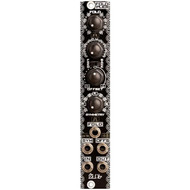Foldiplier - Zlob Modular
by Jason Czyeryk
I’ve never been one to collect things for the sake of some completionist satisfaction; I just don’t have that bone in my body. It’s something I’ve always known about myself, and I take a sort of worthless pride in this aspect of my personality, so imagine my surprise when I realized how excited I was to get Zlob Modular's Foldiplier and put it in my growing system alongside other…quite a few other…Zlob modules. I basically have a pretty good size Zlob corner (upper right) in my rig, and with their black and white faceplate artwork, it looks pretty cool. It’s the most striking looking section of my modular, without question, and it's making me rethink my non-completist, non-collector, idea of myself.
While I am growing fond of this burgeoning neighborhood of modules, it’s not the Zlob aesthetic that keeps me hanging on to them, but rather how they function. Their awesome filterbank (F3DB) is a favorite, as is Vnicursal, their six-channel VCA, among others. I think a big part of it is their all-analog workflow, which is very tactile and intuitive. I’m not sure I’ve ever cracked a Zlob manual more than a couple of times, as once you know what one of their modules does, you don’t have to go too deep with how to do something; it’s all right there in front of you.
Foldiplier is the same, a wavefolder that looks simple enough with just five controls; Fold (with a CV input and attenuator), Offset (with a CV input), Symmetry (also with a CV input), and a Feedback switch. Add an input and output and you’ve seen the whole deal.
Inspired by part of the Serge Wave Multiplier, Foldiplier's feedback path, which has parts of the Hemmo Bazz Fuss circuit (something I was unfamiliar with previously), a five-component transistor-based DIY fuzz, really helps to create Foldiplier's unique signal path.
The controls that make up the bulk of Folidiplier do what you think, but the magic of the circuit produces a unique—almost a bi-timbral, two notes in one—sound, and patching something as simple as a triangle wave through Foldiplier and modulating the Fold with another simple triangle wave is satisfyingly rich. The crazier the input signal the crazier the output gets (no duh!), and being able to run itself through itself via the feedback path creates truly gargantuan distortion and buzz. I always liken feedback to the ouroboros—the snake that eats itself—and that destructive, yet simultaneously reconstructive nature is on full display here. Folidiplier can be downright wrong sounding in the best of ways, and by switching on the Feedback without an input signal present you can utilize Foldiplier as an oscillator, albeit a very experimental one: You won't be getting any nice and easy waveforms out of this!
Being able to CV all of the parameters is key here, and it's important to understand how each of the parameters effects the others. In that way Offset and Symmetry work in tandem; if there's no Offset added, the Symmetry control doesn't do anything—there's nothing to um…symmetricize, nothing to add to the input signal to fold it over itself more, whether in the negative or positive voltage realm.
I really love slowly modulating the wavefolding, getting some robotic formant type sounds; it's so satisfying. Actually, Foldiplier on the whole is incredibly satisfying, and weighing in at only 4HP, it's really easy to find a permanent home for it in my rig.
Price: $166


